|
|
|
|
Lesson 6 |
The 18th century. Clinical anatomy and the pathology of organs. Spallanzani. Jenner |
|
|
|
|
|
|
|
The anatomical wax models were a visual means of teaching and spreading anatomy. Anatomy was still the preserve of educated doctors who knew Latin and who thus had access to textbooks. It was not the arena of surgeons who were lower ranked in status, being barbers in the vast majority of cases, people who had not had a classical education and who had no access to University and to scientific works. The anatomical wax models were produced on a large-scale in Florence, and then exported throughout Europe. Of the organ to be reproduced (for example, the heart) a plaster mould was made that, before it hardened, was split in two by using a string, was reassembled, and then filled with wax. After this, the wax was coloured, and lastly, the sculptor's hand defined all the details.
As seen before, Giovanni Alessandro Brambilla (1728-1800) was the first in central Europe to place surgery on a par with medicine. In other countries this had come about in a more physiological manner, that is to say, the surgeons had become so good that they had become as good as doctors. This occurred in England as John Hunter (1728-1793), a great surgeon, lived there. Hunter carried out an experiment on himself: since it was maintained that it was not possible for a patient to suffer at the same time from two illnesses, in order to establish whether or not blennorrhea and syphilis were two separate diseases or not, he inoculated. his glans penis with pus from a subject suffering from blennorrhea in order to see if blennorrhea or syphilis appeared. He fell ill with syphilis because the subject had both the diseases and Hunter was fortunate because he recovered from it. This experiment was publicised throughout the world and created confusion, because it was seen as evidence that gonorrhea and syphilis were the same disease. In Sassari (north Sardinia) Luigi Rolando (1773-1831) was the author of the essay "The real structure of the brain of man and animals". He followed the fashionable theory of animal electricity, and by touching the cortex of a pig on one side in front of the central sulcus of the brain (rolandic sulcus), provoked muscular contraction. Rolando also compared the cerebellum to a battery and stated that it was involved in control of motion.
This momentous textbook attracted so much interest throughout the world at that time that the first edition was sold out within two years. There followed many other editions and they were translated into all the other European languages. One of the last editions was in Italian, both because Italian doctors were familiar with Latin (until the French Revolution the language of science was Latin), and because in Italy the 'morgagnesque verb' had difficulty taking root. On the other hand, Morgagni's principles were applied and were the basis on which clinical medicine developed in those countries. He influenced Domenico Cotugno and had Antonio Scarpa as one of his pupils. In the same period in which Morgagni published his tract, a small tract appeared in 1761 in Vienna, "De Inventu Novo" in which the son of a cooper called Leopold Auenbrugger (1722-1809) described percussion as a means by which the alterations of the thoracic organs could be observed in living patients. This book remained unknown until the beginning of the 19th century when Napoleon's doctor Jean Nicolas Corvisart (1755-1821) revived clinical percussion. Auenbrugger was still living and, 30 to 40 years after his book's publication, shared in its success. Important problems in the 18th century were those of respiration and of combustion. It had been hypothesised by Georg Ernst Stahl (1660-1730) the existence of a substance called phlogiston that, when consumed, produced fire. However, this concept did not explain several experiments which were carried out by the Oxford school. For example, on placing an animal under a bell with a burning candle, it was observed that as the candle burned the animal showed signs of asphyxia until it died. What connection existed with phlogiston was not understood. It was said that the air had become "fixed air". An Englishman, Joseph Priestley (1733-1804), was the first to suggest that a gas must be consumed. The person who demonstrated that this gas is oxygen was Antoine Laurent Lavoisier (1743-1794), the great scientist and founder of modern chemistry. Lavoisier was guillotined for being an aristocrat. History records that just before being guillotined he was reading a science book!
An Irishman, John T. Needham (1713-1781), stated that the infusoria (which could be seen under the microscope because they were protozoa) were derived from the fluid in the flask, and therefore not from other protozoa. Although his conclusions were supported by the greatest naturalist of the time, Georges Buffon (1707-1788), Spallanzani refuted them, because if the flask also had been sterilised by heat (he was the first to carry out the procedure, which was also applied later by Pasteur), the protozoa did not grow. He demonstrated therefore, that protozoa arise from pre-existing protozoan. This was the first demonstration that very small beings are derived from other very small beings.
There had already been previous attempts, going back to the late 17 century, to eradicate the disease with variolation. The latter consisted of the inoculation in a healthy subject of a small amount of pus taken from a patient who was close to recovering. Unfortunately, this procedure was often lethal and many babies died. Smallpox inoculation was promoted by Lady Montagu, the wife of the British ambassador in Constantinople, because she saw it being practised there as it had been in the Orient for many centuries. This procedure was then introduced into Italy by Greek doctors, who worked in Venice. These Greek doctors had a great champion in Pope Benedict XIV (Pope Lambertini) who tried to introduce smallpox inoculation into the Papal State. Jenner's discovery resolved the problem of smallpox. Jenner's discovery resolved the problem of smallpox. Jenner carried out his first inoculation on his gardener son and later on his own child: he took a small amount of pus from a cow's pustule, then injected his son and could see that the pustule of the vaccination (which was not called vaccination, but a graft) meant the child was protected from smallpox. The vaccination created great interest, even though it was violently opposed by certain parties, above all by clerics who felt it was an insult to the Creator since it was a mixture between the bestial, that is, the animal, and man. Therefore, in the rest of Europe vaccination only took place on a large-scale because the French Revolution occurred. It became a flagship of the left, of the Jacobites. The Jacobites vaccinated, but the reactionaries did not. In Italy, a Milanese, Luigi Sacco (1769-1836) spread vaccination in the Cisalpine Republic causing the death rate from smallpox to fall dramatically.
In 1794 Philippe Pinel (1743-1825) in Paris, and two years before him, Vincenzio Chiarugi (1759-1820) in Florence, set the lunatics free from chains. At this point the discussion about live contagion re-emerges. Among Spallanzani's students was Giuseppe Baronio (1759-1811) who, based on what he had learned from Spallanzani, was the first to perform skin grafts in animals, a precursor to cutaneous grafts and plastic surgery in humans. He was also the first to demonstrate the important principle that an autograft from the same animal would take, whereas an allograft from another animal was rejected. Agostino Bassi (1773-1856) was the son of a wealthy farmer and a lawyer who also had a passion for biology. His father did not want him to take up biology, but wanted him to care after the family's property, to become a civil servant and to join the Imperial administration. All the same, he constantly followed Abbott Spallanzani's lessons until the latter died. One-day the silkworms he kept were infected by a terrible disease, muscardine, that killed the silkworms reducing them to pieces of chalk. Bassi patiently began studying this phenomenon in order to understand whether or not a living organism had been responsible for this phenomenon, and he discovered that a fungus, which was later called Botritis or Beauveria bassiana, had caused the death of these silkworms. He also found a disinfectant that used to prevent this fungus and to clean the rows in which the silkworms were kept. His tract entitled "Del Mal del Segno, Calcinaccio o Moscardino" was translated into French and spread throughout Europe. Immediately afterwards the fungal aetiologies of certain illnesses were discovered, such as tinea (ringworm) in the hair. Louis Pasteur (1822-1895) was greatly influenced by his work (in Pasteur's office there were the portraits of both Spallanzani and of Bassi). At that time the microscope could recognise only fungus and protozoans, for bacteria were too small to be seen. It was only in the 1820s that an astronomer who made telescopes Gian Battista Amici (1786-1863), invented the reflecting prism. (After this, the microscope was perfected by the English and Germans above all). This meant that microscope resolution was greatly improved. In his book Bassi wrote: "I would be very happy if in the future my discoveries serve to open up study and find cures for the fatal diseases which affect mankind, including cholera". In the spirit of this book, the Italian anatomist Filippo Pacini (1812-1883)discovered in 1854 the choleric vibrion in the faeces of cholera sufferers, but this discovery was so ahead of its times that it was ignored.
Eventually, a method for identifying illnesses was found. There was a return to the old school of Cnidos so that the illness, not the person, became the focus of medicine. In this period the means of disease diagnosis came about: although the method which Morgagni had found was the scalpel on the body of a dead person, Auembrugger had already shown that it was possible to carry out the "autopsy" by using percussion. Later, at the beginning of the 19th century, a Frenchman, Renč Laennec (1781-1826), invented the stethoscope. Originally it was composed of a wooden tube which served the purpose of auscultating the thorax. In fact, it was not possible to place the ear on a patient's chest, especially if the patient was a woman, and particularly if she belonged to the upper class. The physician was only allowed to inspect the urine and check the radial pulse at the wrist. Thus medicine took another major step forward in semeiotics: after inspection, auscultation of the heartbeat and percussion were now possible. The "autopsy" now took place on the living, in whom the illness was taken to be as a morbid entity, leaving man out of the consideration. This is the reductionist principle upon which modern medicine is based. |
|
|
From the notes of Manuela Testa |
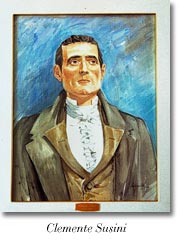 As we have already seen, the wax models which are now in Cagliari were personally made by Clemente Susini (1757-1814), and the wax mixture also contained precious substances, such as splinters of gold and ground pearls in order to make the wax luminous. Moreover, the wax works suffered more from the cold than from the heat because the wax mixture was made of diverse substances with varying degrees of dilation, and when the temperature falls below zero, the smallest vibration was enough to shatter and ruin them. Because in Cagliari never falls below freezing, the waxworks kept there have the status of never having to be restored in contrast to those of the great collections in Florence and in Vienna (the waxworks in Vienna are in part copies of those in Florence, having been made in Florence and brought to Vienna by Giovanni Alessandro Brambilla).
As we have already seen, the wax models which are now in Cagliari were personally made by Clemente Susini (1757-1814), and the wax mixture also contained precious substances, such as splinters of gold and ground pearls in order to make the wax luminous. Moreover, the wax works suffered more from the cold than from the heat because the wax mixture was made of diverse substances with varying degrees of dilation, and when the temperature falls below zero, the smallest vibration was enough to shatter and ruin them. Because in Cagliari never falls below freezing, the waxworks kept there have the status of never having to be restored in contrast to those of the great collections in Florence and in Vienna (the waxworks in Vienna are in part copies of those in Florence, having been made in Florence and brought to Vienna by Giovanni Alessandro Brambilla). 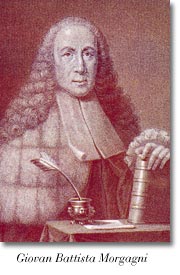 However, the true founder of modern clinical medicine was Giovanni Battista Morgagni (1682-1771). He derived his medicine from the school of Galileo because he was a student of Antonio Valsalva (1666-1723), who in turn was a student of Malpighi, Malpighi of Borelli, and these two had been students of Galileo. Morgagni applied the concept of iatrophysics but used the eye instead of the microscope: according to the principles of his school he tried to discover how organs functioned by regarding them as machines. Morgagni referred to previous publications, the most accurate of which came from the 15th century: in Florence Antonio Benivieni (1443-1502) carried out several autopsies and correlated them with the cause of death. His book is entitled "De abditis morborum causis" (the hidden causes of diseases). Another treatise published in the late 17th century was the "Sepulcretum" by Theofile Bonet (1620-1689), which included anatomical reports of many cases. However, all these reports lacked the correlation between clinical history and anatomic-pathological findings. With Morgagni there was a return to the ancient Alexandrian tripod consisting of clinical history, the autopsy, and then the clinical diagnosis. Morgagni collected 700 autopsies, correlated them with the patient's clinical history, and demonstrated that for the great majority of the diseases the organ had a peculiar pathology. At that time, there was no means of carrying out live autopsies (autopsy as meant by the Alexandrian concept, that is to say, an examination of the patient with the doctor's own eyes), so autopsy was really dissection, but the concept here was that of correlating the clinical history with the disease. Morgagni was a well known anatomist, being called 'his anatomical majesty' throughout Europe because he had published notes on anatomy entitled "Adversaria Anatomica" which became very famous for the notably precise descriptions of details that had been overlooked by previous researches.
However, the true founder of modern clinical medicine was Giovanni Battista Morgagni (1682-1771). He derived his medicine from the school of Galileo because he was a student of Antonio Valsalva (1666-1723), who in turn was a student of Malpighi, Malpighi of Borelli, and these two had been students of Galileo. Morgagni applied the concept of iatrophysics but used the eye instead of the microscope: according to the principles of his school he tried to discover how organs functioned by regarding them as machines. Morgagni referred to previous publications, the most accurate of which came from the 15th century: in Florence Antonio Benivieni (1443-1502) carried out several autopsies and correlated them with the cause of death. His book is entitled "De abditis morborum causis" (the hidden causes of diseases). Another treatise published in the late 17th century was the "Sepulcretum" by Theofile Bonet (1620-1689), which included anatomical reports of many cases. However, all these reports lacked the correlation between clinical history and anatomic-pathological findings. With Morgagni there was a return to the ancient Alexandrian tripod consisting of clinical history, the autopsy, and then the clinical diagnosis. Morgagni collected 700 autopsies, correlated them with the patient's clinical history, and demonstrated that for the great majority of the diseases the organ had a peculiar pathology. At that time, there was no means of carrying out live autopsies (autopsy as meant by the Alexandrian concept, that is to say, an examination of the patient with the doctor's own eyes), so autopsy was really dissection, but the concept here was that of correlating the clinical history with the disease. Morgagni was a well known anatomist, being called 'his anatomical majesty' throughout Europe because he had published notes on anatomy entitled "Adversaria Anatomica" which became very famous for the notably precise descriptions of details that had been overlooked by previous researches. 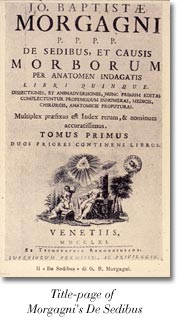 His major work a real milestone in the birth of modern medicine, was published in 5 volumes in 1761 and was dedicated to the most important medical academies of the time. It was published in Latin and entitled “De Sedibus et causis morborum per anatomen indagatis” (On the Sites and Causes of Diseases Studied Through Anatomy). He collected 700 clinical cases, some of which belonged to Malpighi and to his teacher Valsalva, an anatomist who had made many important discoveries, especially about the ear.
His major work a real milestone in the birth of modern medicine, was published in 5 volumes in 1761 and was dedicated to the most important medical academies of the time. It was published in Latin and entitled “De Sedibus et causis morborum per anatomen indagatis” (On the Sites and Causes of Diseases Studied Through Anatomy). He collected 700 clinical cases, some of which belonged to Malpighi and to his teacher Valsalva, an anatomist who had made many important discoveries, especially about the ear. 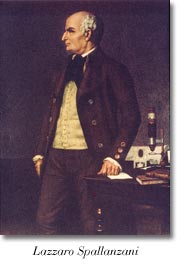 Immediately after the discovery of oxygen, the abbot Lazzaro Spallanzani (1729-1799), one of the greatest scientists who ever lived, worked out the relationship between the consumption of oxygen and tissue respiration. Spallanzani was a great experimenter and showed that during flight, bats navigate using ultrasound; in order to demonstrate the action of gastric juices, he inserted a sponge with some meat inside it into his stomach. The sponge with the meat was removed some hours later so that the effect of gastric juices could be verified. Spallanzani above all is famous in the field of reproduction. By putting a type of waxed underpants on a male toad, he was the first to demonstrate that without contact between the liquid semen and the egg, fecundation was not possible. Later on, he performed the first successful artificial insemination in a bitch. He also discovered white blood cells and demonstrated the existence of capillaries, "the capillamenta", in warm-blooded animals (in the chick), confirming the observations previously (1702) made by William Cowper in the mesentery of cats and dogs. Among Spallanzani's most important discoveries (for which Pasteur revered him) was that of refuting the thesis of spontaneous generation of protozoa. The problem of spontaneous generation was an interest of Redi who demonstrated that insects are derived from other insects. There had been some precursors, for example, among the Italians, Antonio Vallisneri (1661-1730) a Paduan doctor, who thought that there were "Semi" (seeds) in the air, similar to those described by Fracastoro; Carlo Francesco Cogrossi (1682-1769) maintained that bovine plague was transmitted by a living microorganism, responsible for contagion. However, both these theories were disproved.
Immediately after the discovery of oxygen, the abbot Lazzaro Spallanzani (1729-1799), one of the greatest scientists who ever lived, worked out the relationship between the consumption of oxygen and tissue respiration. Spallanzani was a great experimenter and showed that during flight, bats navigate using ultrasound; in order to demonstrate the action of gastric juices, he inserted a sponge with some meat inside it into his stomach. The sponge with the meat was removed some hours later so that the effect of gastric juices could be verified. Spallanzani above all is famous in the field of reproduction. By putting a type of waxed underpants on a male toad, he was the first to demonstrate that without contact between the liquid semen and the egg, fecundation was not possible. Later on, he performed the first successful artificial insemination in a bitch. He also discovered white blood cells and demonstrated the existence of capillaries, "the capillamenta", in warm-blooded animals (in the chick), confirming the observations previously (1702) made by William Cowper in the mesentery of cats and dogs. Among Spallanzani's most important discoveries (for which Pasteur revered him) was that of refuting the thesis of spontaneous generation of protozoa. The problem of spontaneous generation was an interest of Redi who demonstrated that insects are derived from other insects. There had been some precursors, for example, among the Italians, Antonio Vallisneri (1661-1730) a Paduan doctor, who thought that there were "Semi" (seeds) in the air, similar to those described by Fracastoro; Carlo Francesco Cogrossi (1682-1769) maintained that bovine plague was transmitted by a living microorganism, responsible for contagion. However, both these theories were disproved. 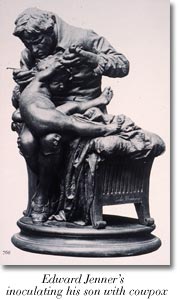 At the end of the 18th century there was a great empirical discovery. An English surgeon Edward Jenner (1749-1823), a student of John Hunter, noticed that milkmaids who had previously suffered from cowpox, always recovered when they fell ill with smallpox. Smallpox was the most terrible and feared of diseases at that time. The plague had nearly disappeared because of the change in the rats and thanks to improved hygiene and, although there existed serious diseases such as tuberculosis and syphilis, the most deadly one was smallpox which affected children.
At the end of the 18th century there was a great empirical discovery. An English surgeon Edward Jenner (1749-1823), a student of John Hunter, noticed that milkmaids who had previously suffered from cowpox, always recovered when they fell ill with smallpox. Smallpox was the most terrible and feared of diseases at that time. The plague had nearly disappeared because of the change in the rats and thanks to improved hygiene and, although there existed serious diseases such as tuberculosis and syphilis, the most deadly one was smallpox which affected children. 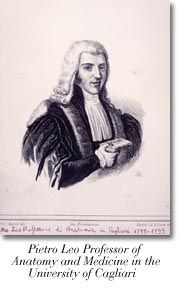 It was Pietro Leo (1766-1905) who introduced the vaccination to Sardinia. He was a Professor of Anatomy and had learnt how to vaccinate in Paris during the French Revolution. Other early apostles of vaccinations in Sardinia were Francesco Antonio Boi and Sebastiano Perra (1772-1826) who wrote a book (1808) on vaccination. At first, however, vaccination spread rather slowly in Sardinia, but was later helped by the work of another professor of anatomy, Giovanni Falconi (1817-1900).
It was Pietro Leo (1766-1905) who introduced the vaccination to Sardinia. He was a Professor of Anatomy and had learnt how to vaccinate in Paris during the French Revolution. Other early apostles of vaccinations in Sardinia were Francesco Antonio Boi and Sebastiano Perra (1772-1826) who wrote a book (1808) on vaccination. At first, however, vaccination spread rather slowly in Sardinia, but was later helped by the work of another professor of anatomy, Giovanni Falconi (1817-1900). 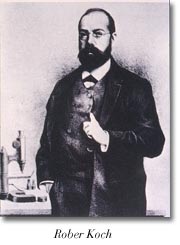 In 1884 Robert Koch (1843-1910) also discovered the choleric vibrion but then emerged that it had already been clearly described by Pacini. There was a long argument that was eventually resolved by giving the credit to Pacini. However, from a practical point of view, this was of little value since his precocious discovery had not spread to the wider scientific community.
In 1884 Robert Koch (1843-1910) also discovered the choleric vibrion but then emerged that it had already been clearly described by Pacini. There was a long argument that was eventually resolved by giving the credit to Pacini. However, from a practical point of view, this was of little value since his precocious discovery had not spread to the wider scientific community.